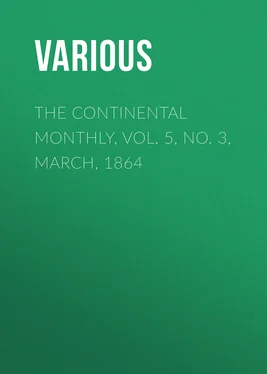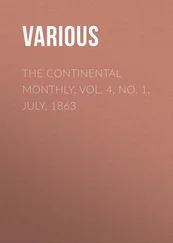Various - The Continental Monthly, Vol. 5, No. 3, March, 1864
Здесь есть возможность читать онлайн «Various - The Continental Monthly, Vol. 5, No. 3, March, 1864» — ознакомительный отрывок электронной книги совершенно бесплатно, а после прочтения отрывка купить полную версию. В некоторых случаях можно слушать аудио, скачать через торрент в формате fb2 и присутствует краткое содержание. Жанр: foreign_antique, periodic, Языкознание, Политика, foreign_edu, на английском языке. Описание произведения, (предисловие) а так же отзывы посетителей доступны на портале библиотеки ЛибКат.
- Название:The Continental Monthly, Vol. 5, No. 3, March, 1864
- Автор:
- Жанр:
- Год:неизвестен
- ISBN:нет данных
- Рейтинг книги:3 / 5. Голосов: 1
-
Избранное:Добавить в избранное
- Отзывы:
-
Ваша оценка:
- 60
- 1
- 2
- 3
- 4
- 5
The Continental Monthly, Vol. 5, No. 3, March, 1864: краткое содержание, описание и аннотация
Предлагаем к чтению аннотацию, описание, краткое содержание или предисловие (зависит от того, что написал сам автор книги «The Continental Monthly, Vol. 5, No. 3, March, 1864»). Если вы не нашли необходимую информацию о книге — напишите в комментариях, мы постараемся отыскать её.
The Continental Monthly, Vol. 5, No. 3, March, 1864 — читать онлайн ознакомительный отрывок
Ниже представлен текст книги, разбитый по страницам. Система сохранения места последней прочитанной страницы, позволяет с удобством читать онлайн бесплатно книгу «The Continental Monthly, Vol. 5, No. 3, March, 1864», без необходимости каждый раз заново искать на чём Вы остановились. Поставьте закладку, и сможете в любой момент перейти на страницу, на которой закончили чтение.
Интервал:
Закладка:
Thus we perceive sculpture as a representative art has become a chronicler of the world's advancement, so that those who accept the theory of human progression would naturally look for purer and more spiritual conceptions in the artist's soul, with a corresponding nobility in the creations of his genius. The æsthetic principle in its higher manifestations is not the product of pagan mind, because ideal beauty and the rules governing its expression can only be conceived by him to whom Faith has opened the glorious possibilities of our existence beyond the grave. In no classic picture or statue is there anything akin to that divine affinity that is apparent in the Madonnas of the Italian masters of the sixteenth century, investing them with a charm that lingers like an autumn sunset In the recollection of long-departed years. Compare the loveliest of the Madonnas of Correggio and Raphael with the Venus of Cos, and we perceive the inferiority of mere physical perfection to that spiritual beauty that exalts the soul of the beholder, and awakens the slumber of his immortal longings.
Faultless finish, harmonious outlines, and voluptuous proportions are only the result of mechanical skill, that a good imitator or copyist can for the most part achieve by the aid of his master's model. But the sentiment, emotion, passion, the character , so to speak, of the statue, is the creation of the artist, the offspring of his quickened brain.
It is to express the æsthetic idea struggling in the soul of genius, that the marble takes its form, the canvas its color, sweet sounds combine in melody, and language weaves itself into the wreath of song. The same divine impulse, the same grasping after a higher excellence inspires the sculptor, the painter, the composer, and the poet, but some chance bent of nature has decided them to choose different mediums of expression.
Some critic has written, had Coles' 'Voyage of Life' been executed in verse, instead of a series of pictures, it would have ranked as one of the grandest poems of the age. High art, then, whatever its kind, is the language of the æsthetic feeling in man—it symbolizes the god-like element in his nature. Cumulative and progressive, it keeps even pace with an improving civilization, and should therefore furnish fairer products to-day than in any period of the past. It assimilates the spirit of the times in which it is exercised; for as Ralph Waldo Emerson remarks in his subtle, essay: 'No man can quite emancipate himself from his age and country, or produce a model in which the education, the religion, the politics, usages, and arts of his times shall have no share.'
So we see from the very necessity of this truism, that if our painters and sculptors would not be mere imitators of the exponents of another age, there would be soon established a national school of art. We do not mean by this a mere conventional type in finish and mode of treatment, but certain marked, characteristic excellences and features that would identify it with the history of our country and the peculiarities of our people. There are a few native artists who have struggled to achieve this consummation, and preëminent among these is Erastus D. Palmer, the American sculptor.
The history of his career, his origin, his process of study, his choice of subjects in all his great works, his rise and triumph as an artist, all entitle him to this distinctive appellation. He commenced life as a carpenter and joiner, but, while practising his trade in Utica, N. Y., his eye accidentally fell on a cameo likeness, and as the dropping of an apple suggested to Newton the laws of gravitation, so the sight of this little trifle was the talisman that revealed to Palmer the artistic capabilities of his genius. Being thus led to attempt the portrait of his wife upon a shell, he executed his task—which was in a twofold sense a labor of love—with such fidelity to nature, such bold outline, and delicacy of finish, that connoisseurs detected in it the hand of a master. Thus encouraged, he for two years made cameo cutting his business, and followed it with remarkable success, till, his eyes becoming affected by the exercise of this talent, he was obliged to relinquish it, with the expectation of returning to his old trade. But happily he was induced to try his skill at modelling in clay, and then he discovered what was in him. Taking his little girl for a model, he produced a bust, styled the 'Infant Ceres,' which, when finished in marble, immediately took rank as one of the gems of art. The sweet naïvete of budding childhood, the timid eyes and dimpled cheek, all refined and sublimated by the ideal graces added by the magic wand of genius, combined to make this earliest bust of our sculptor one of the most felicitous products of his chisel.
Soon after this satisfactory experiment, Palmer removed to the city of Albany, where he has since remained and won his well-deserved fame. His two allegorical pieces, 'Resignation' and 'Spring,' we cannot forbear to describe, familiar as they are to the virtuoso of art, and well known even to the great public.
The latter is a female bust, her hair bound with a fillet of grass and half-developed grain, her face wearing an expression of modest coquetry, quite in keeping with the capricious, 'celestial maid;' while the gently swelling bosom suggests the latent forces of nature which only reach their fulness in the summer sun. And about the eyes there is a look of joy and freshness in which you fancy you can see
'the flowers begin to spring,
The skies to brighten, and the birds to sing.'
The 'Resignation' represents the refined voluptuousness of riper womanhood. The features are exquisitely cut, and represent a type of beauty fit for angelic spheres. The head, so finely proportioned, and crowned with luxuriant, waving hair, inclines gracefully to one side, as in submission to the chastenings of Providence. But in the downcast, sorrowful eyes, there is an expression of mingled hope and patient endurance such as Mary might have worn at the foot of the cross. The marble is eloquent of that Christian sentiment: 'He doeth all things well.' The religious feeling of the sixteenth century, which gave to art both its inspiration and theme, never found so fair a mould as in this bust of 'Resignation.'
Both of these works are entirely free from all explanatory accessories, and interpret themselves to the most sluggish soul.
Another of Palmer's compositions, and one of the most purely ideal, is the 'Dream of the Spirit's Flight.' This is a large bas-relief, executed in medallion style. To give any idea by mere words of the spirit of this performance is impossible. It is the half figure of a peri-like girl, with tresses swaying in the higher air, with butterfly wings, arms and drapery gracefully disposed, and all the parts uniting to impress you with a sense of upward, soaring motion! There is a divine beauty about the face reflected from a brighter world. Sculptured in pure white marble, it seems a very soul just escaped from its prison house of clay, and, listening to those 'sounds seraphic,' bearing away to the great Beyond.
While gazing on this airy sprite, the beholder feels an exhilarating influence steal over him, and involuntarily there goes up from his heart, like incense, that yearning prayer:
'So grant me, God, from every care,
And stain of passion free,
Aloft through virtue's purer air
To hold my course to Thee!'
We cannot speak separately of his 'Morning and Evening,' 'Immortality,' 'Sleeping Peri,' his statue and bas-relief of 'Faith,' busts, and other works, which are grouped in odd companionship about his studio. But the 'Indian Girl' and 'White Captive,' the crowning achievements of Palmer's genius, and the ones that give a thoroughly American character to his reputation, demand an elaborate consideration—not to explain their merits, but to show what materials for art exist in our history, when appropriated by the master's hand.
Читать дальшеИнтервал:
Закладка:
Похожие книги на «The Continental Monthly, Vol. 5, No. 3, March, 1864»
Представляем Вашему вниманию похожие книги на «The Continental Monthly, Vol. 5, No. 3, March, 1864» списком для выбора. Мы отобрали схожую по названию и смыслу литературу в надежде предоставить читателям больше вариантов отыскать новые, интересные, ещё непрочитанные произведения.
Обсуждение, отзывы о книге «The Continental Monthly, Vol. 5, No. 3, March, 1864» и просто собственные мнения читателей. Оставьте ваши комментарии, напишите, что Вы думаете о произведении, его смысле или главных героях. Укажите что конкретно понравилось, а что нет, и почему Вы так считаете.












